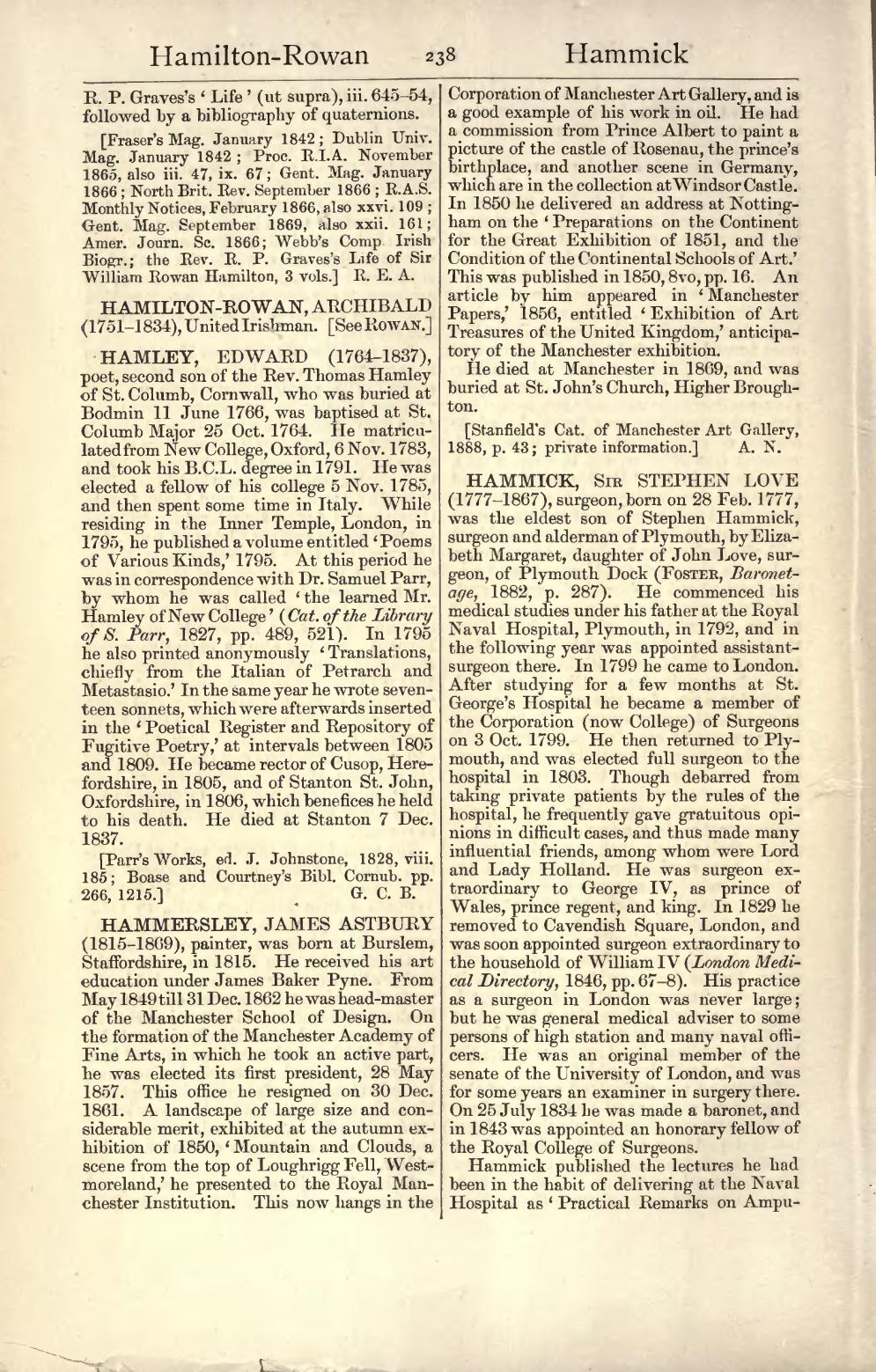R. P. Graves's 'Life' (ut supra), iii. 645-54, followed by a bibliography of quaternions.
[Fraser's Mag. January 1842; Dublin Univ. Mag. January 1842; Proc. R.I.A. November 1865, also iii. 47, ix. 67; Gent. Mag. January 1866; North Brit. Rev. September 1866; R.A.S. Monthly Notices, February 1866, also xxvi. 109; Gent. Mag. September 1869, also xxii. 161; Amer. Journ. Sc. 1866; Webb's Comp. Irish Biogr.; the Rev. R. P. Graves's Life of Sir William Rowan Hamilton, 3 vols.]
HAMILTON-ROWAN, ARCHIBALD (1751–1834), United Irishman. [See Rowan.]
HAMLEY, EDWARD (1764–1837), poet, second son of the Rev. Thomas Hamley of St. Columb, Cornwall, who was buried at Bodmin 11 June 1766, was baptised at St. Columb Major 25 Oct. 1764. He matriculated from New College, Oxford, 6 Nov. 1783, and took his B.C.L. degree in 1791. He was elected a fellow of his college 5 Nov. 1785, and then spent some time in Italy. While residing in the Inner Temple, London, in 1795, he published a volume entitled ‘Poems of Various Kinds,’ 1795. At this period he was in correspondence with Dr. Samuel Parr, by whom he was called ‘the learned Mr. Hamley of New College’ (Cat. of the Library of S. Parr, 1827, pp. 489, 521). In 1795 he also printed anonymously ‘Translations, chiefly from the Italian of Petrarch and Metastasio.’ In the same year he wrote seventeen sonnets, which were afterwards inserted in the ‘Poetical Register and Repository of Fugitive Poetry,’ at intervals between 1805 and 1809. He became rector of Cusop, Herefordshire, in 1805, and of Stanton St. John, Oxfordshire, in 1806, which benefices he held to his death. He died at Stanton 7 Dec. 1837.
[Parr's Works, ed. J. Johnstone, 1828, viii. 185; Boase and Courtney's Bibl. Cornub. pp. 266, 1215.]
HAMMERSLEY, JAMES ASTBURY (1815–1869), painter, was born at Burslem, Staffordshire, in 1815. He received his art education under James Baker Pyne. From May 1849 till 31 Dec. 1862 he was head-master of the Manchester School of Design. On the formation of the Manchester Academy of Fine Arts, in which he took an active part, he was elected its first president, 28 May 1857. This office he resigned on 30 Dec. 1861. A landscape of large size and considerable merit, exhibited at the autumn exhibition of 1850, 'Mountain and Clouds, a scene from the top of Loughrigg Fell, Westmoreland,' he presented to the Royal Manchester Institution. This now hangs in the Corporation of Manchester Art Gallery, and is a good example of his work in oil. He had a commission from Prince Albert to paint a
picture of the castle of Rosenau, the prince's birthplace, and another scene in Germany, which are in the collection at Windsor Castle. In 1850 he delivered an address at Nottingham on the 'Preparations on the Continent for the Great Exhibition of 1851, and the Condition of the Continental Schools of Art.' This was published in 1850, 8vo, pp. 16. An article by him appeared in 'Manchester Papers,' 1856, entitled 'Exhibition of Art Treasures of the United Kingdom,' anticipatory of the Manchester exhibition.
He died at Manchester in 1869, and was buried at St. John's Church, Higher Broughton.
[Stanfield's Cat. of Manchester Art Gallery, 1888, p. 43; private information.]
HAMMICK, Sir STEPHEN LOVE (1777–1867), surgeon, born on 28 Feb. 1777, was the eldest son of Stephen Hammick, surgeon and alderman of Plymouth, by Elizabeth Margaret, daughter of John Love, surgeon, of Plymouth Dock (Foster, Baronetage, 1882, p. 287). He commenced his medical studies under his father at the Royal Naval Hospital, Plymouth, in 1792, and in the following year was appointed assistant-surgeon there. In 1799 he came to London. After studying for a few months at St. George's Hospital he became a member of the Corporation (now College) of Surgeons on 3 Oct. 1799. He then returned to Plymouth, and was elected full surgeon to the hospital in 1803. Though debarred from taking private patients by the rules of the hospital, he frequently gave gratuitous opinions in difficult cases, and thus made many influential friends, among whom were Lord and Lady Holland. He was surgeon extraordinary to George IV, as prince of Wales, prince regent, and king. In 1829 he removed to Cavendish Square, London, and was soon appointed surgeon extraordinary to the household of William IV (London Medical Directory, 1846, pp. 67-8). His practice as a surgeon in London was never large; but he was general medical adviser to some persons of high station and many naval officers. He was an original member of the senate of the University of London, and was for some years an examiner in surgery there. On 25 July 1834 he was made a baronet, and in 1843 was appointed an honorary fellow of the Royal College of Surgeons.
Hammick published the lectures he had been in the habit of delivering at the Naval Hospital as 'Practical Remarks on Ampu-
